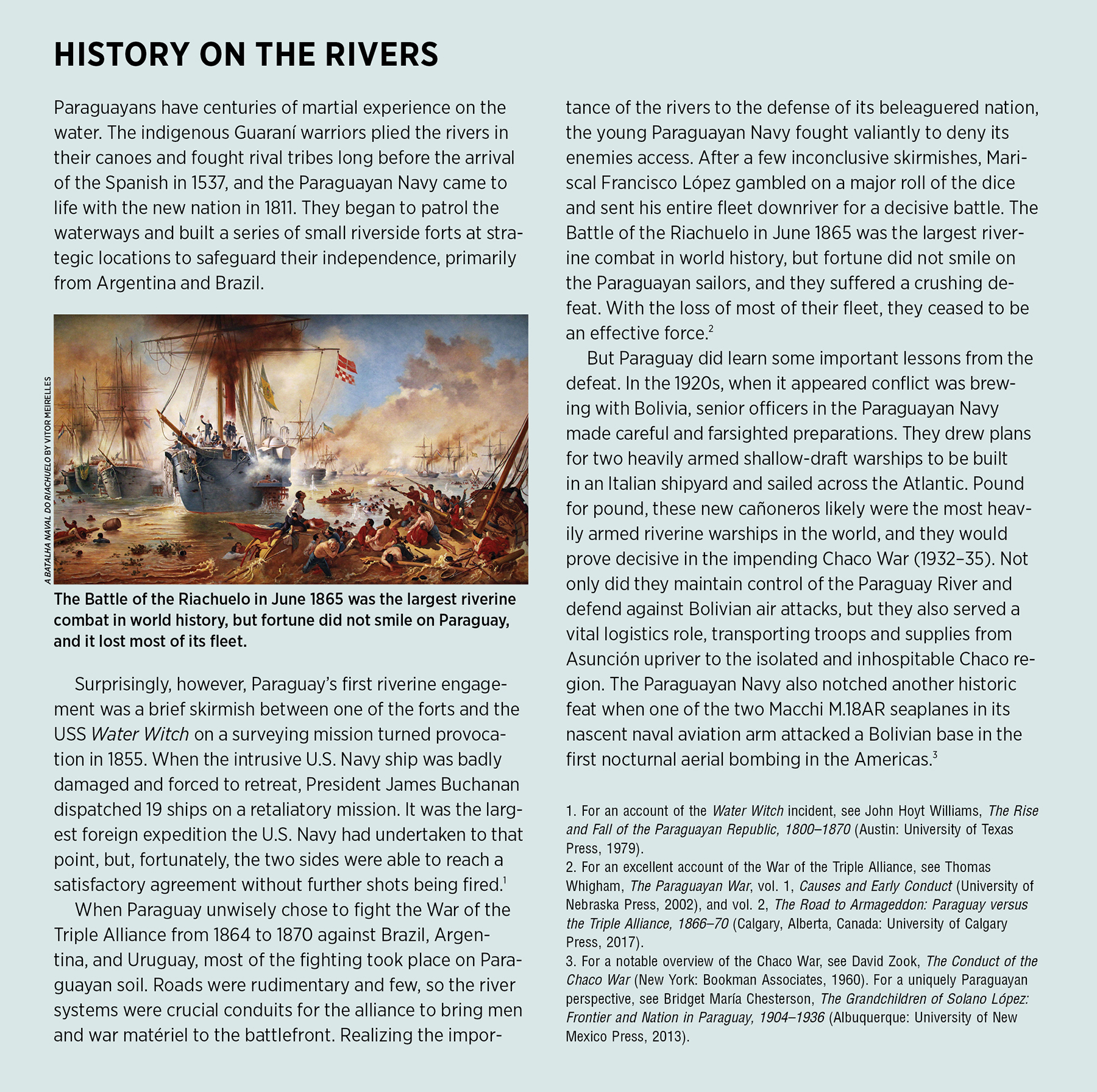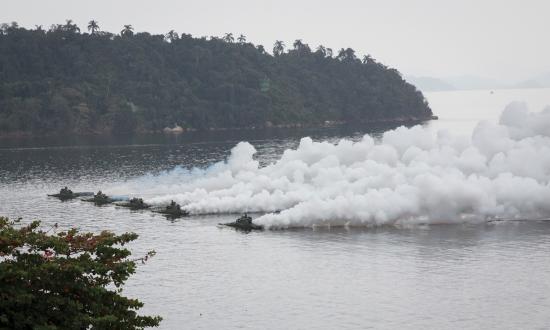My assignment as the first Navy section chief in the Security Cooperation Office at the U.S. embassy in Paraguay brought the predictable raised eyebrows and confused questions. “Why would they send you to Paraguay? Aren’t they landlocked? Do they even have a navy?”
Such confusion is natural from anyone who pictures a navy as blue-water warships operating in expansive formations on the open ocean. But navies can be brown-water as well, as our own experiences in Vietnam and Iraq have taught us. And as we learned, a different operating environment requires a different mind-set and skills.
Among landlocked navies, the Armada Paraguaya has a strong claim as the premier force. However, the twin factors of geography and criminal enterprise have left it with a prodigious challenge in riverine security. Drug smuggling on Paraguay’s rivers is widespread and insidious, and Brazilian gangs use the sizable profits to commit violence and sow instability throughout the region. The Paraguayan Navy is the only organization that can put a dent in this engine of misery and corruption, and U.S. support to its mission would be a wise investment in regional security.
Key Crossroads
Paraguay is a nation of interwoven rivers, with more than 5,000 miles of waterways that extend throughout its territory. Some are so shallow that not even outboard motors can be used safely, while the Paraná is referred to by Paraguayans as “the river with the characteristics of a sea” because of its width and swift currents. The country’s central position astride two major continental rivers makes it a key crossroads in South America. For this reason, it possesses not only a small but competent brown-water navy, but also the third-largest riverine merchant marine in the world.
Rivers are the lifeblood of Paraguay’s economy; 80 percent of all imports and exports flow on its extensive network of internal and border waterways. Unfortunately, massive quantities of illicit goods also flow on the expansive Paraguay and Paraná rivers, which come together at Paraguay’s southwest corner before eventually flowing out to the Atlantic Ocean as the Río de la Plata.
Drug Routes
Although interstate armed conflict has been on the decline in Latin America, transnational criminal organizations (TCOs) are the new enemies of the region. Unhindered by petty inconveniences such as regulations and borders, and with enormous tax-free revenues that often enable them to be better armed and equipped than the governmental organizations trying to stop them, TCOs are the modern scourge of the Western Hemisphere. They use a variety of brutal methods to generate revenue, such as kidnapping for ransom, protection rackets, and human trafficking, but their biggest source of income remains the lucrative illegal drug trade. Massive amounts of Peruvian and Bolivian cocaine traverse the continent on Paraguay’s rivers, to the tune of well more than 100 metric tons per year—that we know about.1
Traditionally, the United States has not paid attention to this drug flow, because it does not go north to U.S. territory. The drugs that pass through Paraguay are destined in part for the South American market, especially Brazil, which is the second-largest global consumer of cocaine after the United States. Large drug shipments also cross the Atlantic for markets in Europe and Africa, with small quantities continuing on to Asia and Australia.
Sizable quantities of cocaine have been discovered concealed in shipping containers as far away as Germany and Spain. In one notable example, in August 2019, German authorities made the largest drug bust in their history when 4.5 tons of cocaine valued at more than $1 billion was discovered in a shipping container that had originated in Montevideo, Uruguay.2 It is highly likely the cocaine in that container came down the Paraguay River to be repackaged in Uruguay before transshipment to Europe, a common tactic.
Although cocaine draws more headlines, marijuana also is a significant problem. Paraguay is the second-largest producer of marijuana in the world, second only to Mexico.3 The Paraguayan Navy regularly interdicts illicit shipments of marijuana crossing the Paraná River to Brazil, often seizing multiple tons over the course of a few months.4 But what it is able to interdict with its limited resources is likely only a fraction of what makes it across the largely uncontrolled border.
Brazilian criminal gangs such as the Primeiro Comando da Capital (PCC) and Comando Vermelho are some of the most dangerous in the region, and their involvement in the drug trade provides them with a hefty bankroll. The ranks of the PCC number approximately 20,000, although 6,000 of those are conducting their criminal activities from jail. Systematic bribery and investments in military-grade weaponry allow them to operate with near-impunity in some areas where security forces can be co-opted or heavily outgunned, such as the mostly unregulated border between Paraguay and Brazil. In 2017, a daring daytime assault with heavy firepower (including hand grenades and C-4 plastic explosives) and sophisticated tactics on the vault of a prominent private security firm in Ciudad del Este netted the PCC up to $40 million in cash.5 The money from the drugs that flow on Paraguay’s rivers provides the bankroll for the gangs’ other more violent criminal endeavors.
A Worthy Partner
If the United States cares about regional security in South America and combating the criminal gangs in Brazil, it should be concerned with drug trafficking on Paraguay’s rivers. The PCC and other TCOs like them are clearly a major destabilizing factor in the region, and they are only growing bolder.
The Paraguayan Navy is the only governmental body with law enforcement authority on the country’s rivers and lakes. The Prefectura functions as a coast guard inside the Navy writ large and is the designated river police. Its jurisdiction includes all rivers, lakes, ponds, streams, and, as the joke goes, any large puddles. It also has authority to conduct or continue any of its law enforcement actions within 50 meters of any body of water. Anything that floats cannot legally be touched by the national police. That means that if the United States wants to combat the flow of drugs that affects the entire Southern Cone, the Paraguayan Navy is the only viable partner.
The Paraguayan Navy faces many challenges. The military does not enjoy a large budget, and the Army receives the lion’s share. More than 90 percent of the Navy’s budget is obligated for salaries and pensions, leaving very little for fuel and ammunition to conduct operations and training. The sheer expanse of waterways to patrol and control would be a daunting task for a force twice its size. It also frequently suffers from a shortage of experienced officers, since many are lured away by the opportunity to triple their wages serving in the merchant marine.
Nevertheless, despite its challenges, the Paraguayan Navy is a worthy and critical partner for the United States in the struggle against the TCOs that threaten regional security in Latin America. U.S. Southern Command should devote significant attention to how it can support the Paraguayan Navy in its efforts to keep South America’s critical rivers from being used to fill the war chests of criminal adversaries.
1. U.S. Embassy Asunción DEA estimate, 2017.
2. Christopher Brito, “$1.1 billion Worth of Cocaine Disguised as Soybeans Seized by German Authorities,” CBS News, 2 August 2019.
3. Laurence Blair, “Paraguay Deploys Anti-narco Top Guns to Combat Economic Need for Weed,” The Guardian, 25 July 2015; and “Mexico, Paraguay Top Pot Producers, U.N. Report Says,” CNN.
4. Juan Delgado, “Paraguayan Navy Seizes Almost 500 Kg of Marijuana,” Diálogo, 29 July 2020; and Eduardo Szklarz, “Paraguay: Narcotics Agents Destroy More than 9 Tons of Marijuana Bound for Brazil,” Diálogo, 6 August 2020.
5. Sofia Lotto Persio, “Brazilian Prison Gang Steals Millions in Paraguay’s ‘Robbery of the Century,’” Newsweek, 25 April 2017; and “Paraguay Robbery: Huge Brazilian Gang Mounts Multi-million-dollar Raid on Armoured Car Firm, Four Dead,” ABC, 25 April 2017.










